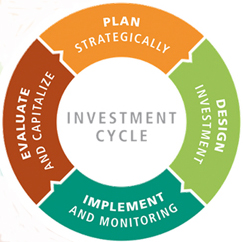Investment Cycle Phases
Investment decisions are not one off decisions. Public and private actors repeatedly or continuously make choices that shape investments and have impacts on higher development goals. The cycle is a way to conceptualize different phases of investment decision making. Taking this step-by-step approach is proposed to improve the quality and enhance the results of ongoing and future investment operations. The cycle distinguishes four phases. Different organizations and approaches have further split these phases into more steps, but the overall coverage of issues and sequence is broadly equivalent.
The cycle is relevant to all levels of investment choices: for investment plans, which set the broad sector investment priorities, as well as for investment programmes and projects. Programmes generally cover broad areas of work required to implement policies and they may be defined along sectoral or geographic boundaries, or be the umbrella for a set of projects that have common objectives. The distinction between project and programmes is not necessarily one of size –be it geographical or financial. A small programme in one area may be smaller than a large project in another. What generally distinguishes projects from programmes is that projects have a set time period and financial envelope for implementation, as well as clear management responsibilities for delivery.

The four phases of the investment cycle are:
1. Plan Strategically
Assess, set and communicate sector priorities, and identify projects for implementation.
2. Design Investment
Analyze context and alternatives and carry out detailed project design.
3. Implement and Monitor
Get the job done, monitor and communicate progress towards objectives, make necessary adjustments.
4. Evaluate and Capitalize
Review and evaluate implementation experience to inform scaling up and future plans and projects.
